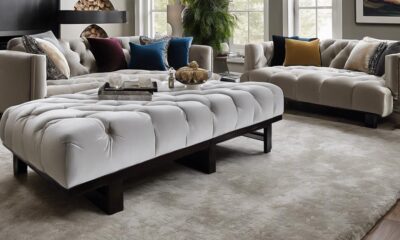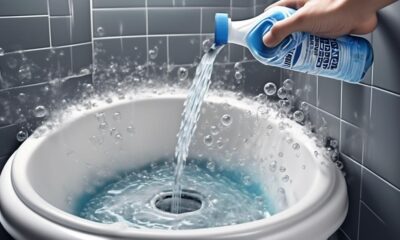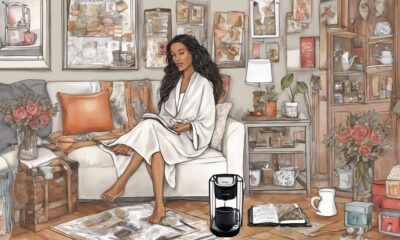Beginners Guides
Rheem Vs Carrier 2022
2025
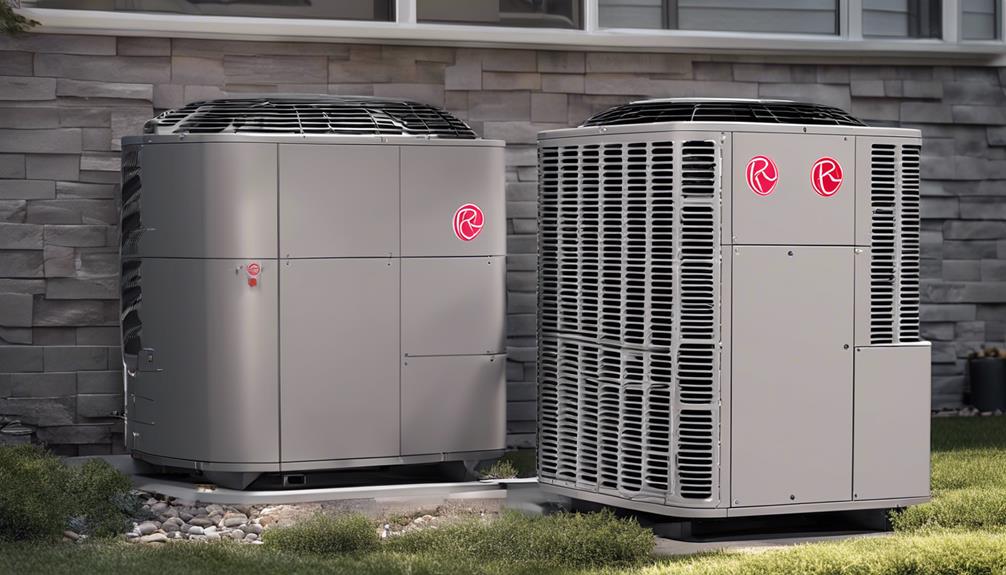
As we delve into the complex realm of HVAC systems, the age-old argument of Rheem versus Carrier is reignited with fresh enthusiasm in 2022.
Both brands boast a rich legacy and a plethora of products, but which one prevails in this year's showdown?
With a focus on performance, reliability, and value, we aim to unravel the intricacies of these industry giants to help you make an informed decision for your heating and cooling needs.
Key Takeaways
- Rheem and Carrier both have a long history of innovation and are renowned for their reliable HVAC systems.
- Carrier's Infinity Series offers exceptional performance and enhanced comfort features, while Rheem's Prestige Series offers advanced performance with modulating technology.
- Both brands are committed to delivering energy-efficient solutions, with Carrier's products having high SEER ratings and Rheem focusing on providing eco-friendly solutions with EcoNet-enabled systems.
- Rheem's product line includes air conditioners with EcoNet technology and ProTerra Hybrid Electric Water Heaters, while Carrier's range includes the Infinity Series with Greenspeed Intelligence and the Infinity 26 Air Conditioner with Greenspeed Intelligence.
Brand Overview and History
We'll start by examining the brand overviews and histories of Rheem and Carrier to provide a comprehensive understanding of their backgrounds and evolution in the HVAC industry.
Rheem, founded in 1925, has a rich history of innovation in heating, cooling, and water heating products. Over the years, Rheem has evolved into a global leader, known for pioneering the development of efficient HVAC solutions.
Similarly, Carrier, established in 1915, has a longstanding history of revolutionizing the air conditioning industry. With the invention of modern air conditioning by its founder, Willis Carrier, the brand has continually set the standard for HVAC technology.
Both companies have a strong legacy of innovation, driving them to develop cutting-edge products and solutions that have shaped the HVAC industry.
Performance and Efficiency Comparison

Both Rheem and Carrier have leveraged their rich histories of innovation to develop high-performance and efficient HVAC solutions, setting the stage for a detailed comparison of their respective products.
When it comes to performance comparison, both brands offer a range of heating and cooling systems designed to meet various needs. Carrier's Infinity Series boasts exceptional performance with precise control and enhanced comfort features. On the other hand, Rheem's Prestige Series also offers advanced performance with modulating technology for optimal efficiency and comfort.
In terms of energy efficiency, Carrier's products are known for their high SEER (Seasonal Energy Efficiency Ratio) ratings, ensuring cost-effective operation. Rheem, on the other hand, focuses on providing eco-friendly solutions with its EcoNet-enabled systems, allowing for energy usage monitoring and optimization.
Both brands are committed to delivering energy-efficient solutions, making them competitive in the market. It's important to assess the specific needs of your space and consider factors such as climate, budget, and long-term energy savings when making a decision between these two leading HVAC manufacturers.
Product Range and Features
Taking a comprehensive look at their respective product ranges and features, Rheem and Carrier offer a diverse selection of HVAC systems tailored to meet varying requirements.
- Product Range: Both Rheem and Carrier boast an extensive product range, including air conditioners, heat pumps, furnaces, and packaged systems. Rheem's product line encompasses innovative air conditioners with features such as EcoNet technology for enhanced control and efficiency. On the other hand, Carrier's range includes the Infinity® Series with Greenspeed® Intelligence, providing precise comfort and exceptional energy efficiency.
- Technological Advancements: Rheem integrates advanced technologies like ProTerra Hybrid Electric Water Heaters, which offer high-efficiency performance and smart features for energy savings. Carrier's products feature technological advancements such as the Infinity® 26 Air Conditioner with Greenspeed® Intelligence, delivering optimal comfort and unparalleled energy efficiency through variable-speed operation.
- Special Features: Rheem's product lineup includes specialized features like the EcoNet Smart Thermostat, designed for seamless integration with various Rheem products for precise control and energy savings. Carrier offers features like the Infinity® Touch Control, a user-friendly interface that provides advanced monitoring and control of the HVAC system.
- Customization Options: Both brands provide customizable options to cater to diverse consumer needs, offering a range of sizes, capacities, and efficiency levels to suit various residential and commercial applications.
Reliability and Warranty Coverage
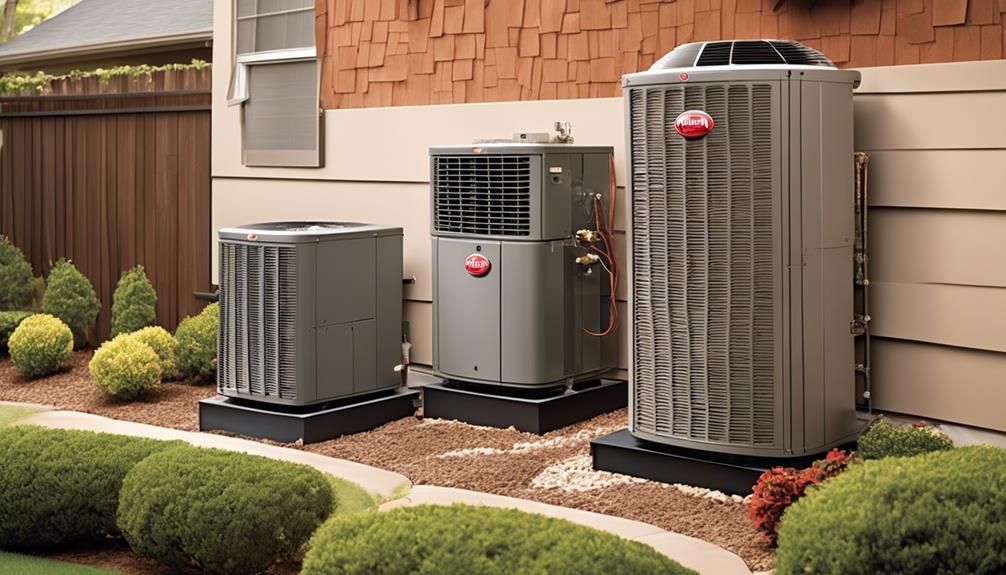
In evaluating the reliability and warranty coverage of Rheem and Carrier HVAC systems, it's essential to examine the specific terms and conditions provided by each manufacturer to ensure comprehensive understanding and informed decision-making.
When comparing the reliability of Rheem and Carrier HVAC systems, it's crucial to consider factors such as the frequency of repairs, lifespan of the units, and overall performance. Both Rheem and Carrier are renowned for producing reliable HVAC systems, with a track record of providing efficient and durable products. However, a thorough reliability comparison should involve analyzing customer reviews, industry ratings, and expert assessments to gain a comprehensive understanding of the long-term performance of these systems.
Regarding warranty benefits, Rheem and Carrier offer competitive coverage to protect consumers against unexpected malfunctions or issues. Both manufacturers provide limited warranties that cover parts and, in some cases, compressor replacements. It's important for consumers to carefully review the warranty terms, including the duration of coverage and any specific conditions or limitations.
Understanding the warranty benefits offered by Rheem and Carrier is crucial for making an informed decision and ensuring long-term peace of mind.
Cost and Value Analysis
Comparing the reliability and warranty coverage of Rheem and Carrier HVAC systems has provided valuable insights. Now, turning our attention to the cost and value analysis, it's imperative to scrutinize the initial investment and long-term benefits offered by both manufacturers.
- Cost Comparison: Evaluating the upfront cost of purchasing and installing Rheem and Carrier HVAC systems is essential. This includes considering the initial price of the units, any additional installation expenses, and potential rebates or financing options.
- Energy Efficiency: Long-term investment benefits are closely tied to energy efficiency. Assessing the energy efficiency ratings and potential savings over the lifespan of the HVAC systems is crucial in determining their overall value.
- Maintenance and Repairs: Analyzing the long-term costs associated with maintenance and potential repairs for both Rheem and Carrier systems is essential for understanding the overall cost of ownership.
- Warranty Coverage: Examining the warranty offerings of both manufacturers is vital. This entails assessing the length of coverage, what components are included, and any additional warranty options available.
When considering the cost and value analysis of Rheem and Carrier HVAC systems, it's vital to weigh the initial investment against the long-term benefits, including energy efficiency, maintenance, and warranty coverage.
Frequently Asked Questions
What Are the Environmental Sustainability Initiatives of Rheem and Carrier, and How Do They Compare in Terms of Their Commitment to Reducing Carbon Emissions?
We prioritize environmental sustainability through innovative solutions for reducing carbon emissions. Our commitment to environmental responsibility drives our initiatives to integrate smart home technology and streamline installation requirements.
Our focus on reducing carbon emissions aligns with industry standards and reflects our dedication to sustainability. By employing advanced technologies and efficient systems, we strive to minimize our environmental impact and contribute to a greener future.
Can Rheem and Carrier Products Be Integrated With Smart Home Technology, and Are There Any Notable Differences in Their Compatibility With Different Systems?
We've researched the smart home compatibility and system integration of Rheem and Carrier products. Both brands offer integration with smart home technology, but there are differences in compatibility with different systems.
Rheem has made strides in environmental impact and carbon reduction, reflected in their product features.
Carrier also offers smart home integration, but their approach to environmental sustainability may differ.
Our technical analysis can help you make an informed decision based on your specific smart home and environmental priorities.
Are There Any Specific Installation Requirements or Considerations for Rheem and Carrier Products That Consumers Should Be Aware of Before Making a Purchase?
Before purchasing, it's crucial to consider installation requirements, energy efficiency, cost comparisons, and product reliability for Rheem and Carrier products.
Both brands may have specific installation needs, such as space, electrical requirements, and ventilation.
Additionally, energy efficiency ratings vary among models, impacting long-term operating costs.
Lastly, researching product reliability through customer reviews and expert opinions can aid in making an informed decision.
How Do Rheem and Carrier Compare in Terms of Customer Service and Support, Including Availability of Authorized Service Technicians and Response Times for Warranty Claims?
In comparing customer service and support for HVAC systems, customer satisfaction is key. Availability of authorized technicians, quick warranty response times, and smart home integration are crucial. These factors can greatly impact our overall experience and peace of mind.
Understanding the level of support and service offered by Rheem and Carrier can help us make an informed decision when selecting a heating and cooling system.
What Are the Anticipated Future Developments or Innovations in the HVAC Industry, and How Do Rheem and Carrier Position Themselves for These Advancements?
In the HVAC industry, future innovations and technological advancements are driving the focus towards environmental sustainability and smart home integration.
Companies like Rheem and Carrier are positioning themselves for these advancements by investing in research and development, enhancing installation considerations, and improving customer service and warranty support.
Anticipated developments include more energy-efficient systems, advanced air purification technologies, and seamless smart home integration, all of which both companies are actively addressing.
What are the differences between Rheem and Carrier air conditioning systems?
When it comes to the carrier vs payne comparison, Rheem and Carrier air conditioning systems have several differences. While both brands offer high-quality and reliable products, Carrier tends to be more expensive but offers advanced technological features. On the other hand, Rheem is known for its energy efficiency and lower price points.
Conclusion
In conclusion, when comparing Rheem and Carrier for 2022, both brands offer high performance and efficiency.
Rheem provides reliable products with a strong warranty, while Carrier offers a diverse range of features and options.
The cost and value analysis shows that both brands have their strengths.
Ultimately, the decision comes down to individual needs and preferences, with Rheem and Carrier standing side by side as reputable choices for heating and cooling systems.
- About the Author
- Latest Posts
Introducing Ron, the home decor aficionado at ByRetreat, whose passion for creating beautiful and inviting spaces is at the heart of his work. With his deep knowledge of home decor and his innate sense of style, Ron brings a wealth of expertise and a keen eye for detail to the ByRetreat team.
Ron’s love for home decor goes beyond aesthetics; he understands that our surroundings play a significant role in our overall well-being and productivity. With this in mind, Ron is dedicated to transforming remote workspaces into havens of comfort, functionality, and beauty.


You can go on a walking tour during the holidays in Cleveland to enjoy the festive decorations. The city will be fully decorated starting on December 1st. Additionally, you can explore concerts and displays throughout the town. Decorating your home during the holiday season is a great way to get into the festive spirit.
Holiday walking tours
There are many choices to choose from, whether you prefer traditional or modern decor. Cleveland is home to numerous hotels that decorate their rooms in honor of the holidays. A holiday-themed hotel in Cleveland is a great way to celebrate the holiday season. Visitors can also visit the nearby Cleveland Art Museum, Cleveland Botanical Garden and Cleveland Museum of Natural History.
The holiday spirit in Cleveland is unbeatable. The city is covered in snow and has a chilly winter climate, but you’ll still find plenty of places to visit and make your spirits soar. Whether you’re traveling by car or taking the scenic route, you’ll want to be prepared to enjoy the most merry Christmas in Cleveland!
There are many reasons to visit Cleveland during the holiday season, including the Cleveland Arcade, the city’s first indoor mall. This iconic structure is known for its iconic architecture and will be especially festive during the holidays. You can also visit the nearby Marriott at Key Center, which will have a giant gingerbread display, as well as outdoor holiday lights and a gingerbread house competition.
The Holiday Light Shows are another way to experience the holiday spirit in Cleveland. Throughout the month of December, the Terminal Tower puts on a light show that runs from four to ten p.m. Each night, until early January, a different display is set up. The Tower City and JACK Cleveland Casino have a large Christmas tree. Downtown is also a good option for holiday fun, with the Cleveland Arcade putting up a twinkling garland and a sparkly Christmas tree.
Holiday displays
There are many ways to decorate your home for Christmas in Cleveland Ohio. Some people start their decorating around Thanksgiving, others wait until after Thanksgiving, and yet others start decorating early. Astrid Smith and her family started decorating in the first week of November. They have been spending more time at their home this year for a variety of reasons. However, they also bought more decorations, especially for the outside.
The Cleveland area offers a number of holiday light displays, including drive-thru displays. There’s something to suit every budget. Public Square is decorated for Christmas with a huge tree, ice skating rink and thousands of lights. If you are looking for something for everyone, there are many shops that are open year-round. Don’t forget the Christmas markets in Cleveland!
Cleveland’s city parks are also beautiful during the holiday season. Visitors can see holiday decorations at the Cleveland Botanical Garden. The gardens are decorated with beautiful trees, making them the perfect backdrop for the holiday season. The Crystal Palace gazebo also houses a huge Christmas tree. Lakeshore Park is also a gorgeous place to spend the holiday season and enjoy the drive-through display.
Visit the Holiday Lights at Nela Park for a great way to celebrate Christmas in Cleveland. This popular display is close to 100 years old. The lights stretch for several blocks along Noble Road and include hot air balloons, reindeer, snowmen, and a replica of the National Christmas Tree. The show will remain open for the entire holiday season until 2022.
An area of the city has a popular display that features more than 10,000 lights. This display will be a mile and a quarter long and will feature twelve large artificial and real trees. The two largest trees are 35 feet tall, and there’s also a fifty-foot tree of lights in the front yard. There are also numerous handmade items in the yard and a 12-foot snowman.
The light show is free and runs every night. It features thousands of lights, hundreds upon hundreds of blow-molds and a Nativity scene. Inflatables and wood cutouts are also included. This show is scheduled to run from Thanksgiving night until January 6 2022. Schedule: Friday and Saturday, 5:30 p.m.-11:30 p.m. and Saturday, 5:30 p.m.-11:30 p.m.
Can I Design my House to Incorporate Christmas Decorations?
When it comes to designing a house, many individuals wonder if it is possible to incorporate Christmas decorations into their home’s design. The answer is a resounding yes! By carefully planning the layout, selecting versatile furniture, and adding festive touches like color schemes and lighting, you can create a space that seamlessly integrates Christmas decor. Whether it’s a Christmas tree in the living room or garlands adorning the staircase, your house can be transformed into a winter wonderland during the holiday season.
Holiday concerts
You’re here because you want to know how to decorate your Cleveland Ohio home for Christmas. There are several companies in the area that offer services that will make the holidays less stressful. These companies are staffed by professionals who are experienced in creating holiday displays. Some companies also offer Christmas light installation services.
Located 40 minutes east of downtown Cleveland, Chardon puts on a holiday show that is second to none. A special lighting ceremony starts the holiday season, and there’s hot chocolate and a live performance with Santa and Mrs. Claus. There are also several holiday events and festivities organized by the Downtown Chardon Chamber of Commerce.
If you have children, a trip to the Cleveland Metroparks Zoo is a great option for a family outing. This enchanting holiday attraction will transform into a winter wonderland with more than a million lights and holiday-themed displays. Children can also enjoy special events, such as photo opportunities with Santa Claus and live musical performances. The Zoo will also host drive-through and walk-through experiences.
Nela Park’s GE Lighting is a family favourite. It boasts nearly a million LED lights, a giant tree, snowmen and Santa’s reindeer. A replica of the National Christmas Tree is also available, which will be up until 2022.
- About the Author
- Latest Posts
Introducing Charles, the Editor in Chief at ByRetreat, whose passion for interior design and editorial excellence elevates every remote workspace to new heights. With his keen eye for detail, impeccable taste, and expertise in design, Charles brings a wealth of knowledge and creativity to the ByRetreat team.
As the Editor in Chief of a renowned lifestyle blog, Charles has honed his skills in curating captivating content and staying up-to-date with the latest trends in interior design. His deep understanding of aesthetics and the power of storytelling through design enables him to create remote workspaces that are not only visually stunning but also rich in personality and meaning.


This article will explore how Florida residents decorate their homes for the holidays. While traditional Christmas trees are a popular choice, some people opt for unique decorations like starfish or seashells. You might even want to consider adding another tree to your holiday decor.
Are There Any Unique Decorations or Traditions for Christmas in Miami That Can Be Adapted for Long Beach?
In Miami, it’s common to see palm trees adorned with lights and ornaments as a unique way to decorate home for Christmas. This tropical twist on traditional decor could easily be adapted for Long Beach, offering a fresh and festive approach to holiday traditions in a coastal setting.
Holiday decorations
Whether you live in Miami Florida or you visit frequently, the holiday season can be an enjoyable time of year to decorate your home with holiday decor. You can hire someone to decorate your home if you don’t have enough time or the right knowledge. This will save you the trouble of buying decorations and spending a lot of money.
There are many beautiful ways to decorate your home for the holiday season in Miami. There are dozens of Christmas-themed activities throughout the city, including the famous Santa’s Enchanted Forest, the world’s largest Christmas-themed amusement park. This park offers 100 rides, a petting zoo, and interactive games. Bayfront Park is another great spot to visit for holiday celebrations.
A Christmas tree is another way to decorate your home during the holidays. A beautiful artificial tree can be purchased in Miami. It will look amazing on your property and you will want to share photo collages on social networks. Buying a pre-lit tree from Miami Christmas Lights will guarantee a spectacular holiday display for your property.
Florida is not the same as other states when it comes to decorating for the holiday season. Floridians choose to decorate their homes with starfish- or seashell-shaped ornaments instead of traditional Christmas trees. You can also use new-style LED lights to cut down on energy costs and ensure unique coloration. You can also use a beige tree skirt to create a beach-inspired effect.
Can I Incorporate Christmas Decorations into My Miami Cruise Vacation?
Planning your Miami cruise port vacation? Don’t leave out the holiday spirit! Incorporate Christmas decorations into your trip by visiting festive spots around Miami before setting sail. Take a few extra steps to add some cheer to your cruise experience and create lasting memories with a touch of holiday magic.
Holiday trees
Miami Christmas Lights is a full-service holiday decorating company that can help you, whether you are a first-time homeowner. This Miami company specializes in luxury residential and commercial holiday decor. Their talented team has the experience and artistic talent necessary to create stunning holiday displays.
Although it may not look like Miami is a winter wonderland at first glance, Miami can be very festive. You can find ornaments ranging from cupcakes to angels. These ornaments are unique and high quality. And if you have kids, you can decorate your home with a tree that will keep them entertained.
Miami has a rich history celebrating the holidays. From reindeer on snowless rooftops to holiday lights twined around palm trees, the city has always been a holiday destination. Residential neighborhoods have also been known for their spectacular displays. 6140 SW 46 Terrace, for example, has a reindeer and sleigh. Another popular home on SW 36 Street and 75th Court features a massive Christmas tree with Santa at the top.
Miami is known for its holiday celebrations, and is considered the party capital of Florida. There are many places to visit during Christmas. Besides your own home, you can also visit Santa’s Enchanted Forest, which is the largest Christmas themed amusement park in the world. The event also includes a petting zoo and interactive games. Bayfront Park is also decorated with a 50-foot Christmas Tree.
The beach is another great place to decorate for the holidays. Floridians use traditional Christmas trees but may use other decorations such as seashells and starfish. If you’re decorating for a holiday party, you may want to choose a tree decorated in the theme of the beach. In addition, Florida is known for beautiful weather, which makes it easy to decorate a home for the holidays with a coastal theme.
- About the Author
- Latest Posts
Introducing Charles, the Editor in Chief at ByRetreat, whose passion for interior design and editorial excellence elevates every remote workspace to new heights. With his keen eye for detail, impeccable taste, and expertise in design, Charles brings a wealth of knowledge and creativity to the ByRetreat team.
As the Editor in Chief of a renowned lifestyle blog, Charles has honed his skills in curating captivating content and staying up-to-date with the latest trends in interior design. His deep understanding of aesthetics and the power of storytelling through design enables him to create remote workspaces that are not only visually stunning but also rich in personality and meaning.

During the holidays, numerous individuals adorn their residences in various ways. This may involve utilizing Christmas tree skirts, Poinsettia plants, holiday stockings, and light shows. While there are other choices besides holiday decor, it can certainly add joy to your home.

Christmas tree skirts
There are many options available if you are thinking of adding a Christmas tree skirt in your home this holiday season. There are two options: traditional white or colorful tree skirts, as well as a variety of styles. You can personalize the skirts by adding a message. These holiday decorations are sure to bring you and your family great cheer.
Christmas tree skirts can be a fun and stylish way of dressing up your Christmas tree. The right one can bring your tree to life. You can choose a skirt with a fun pattern or one with pom-poms or candy canes.
Poinsettia plants
Poinsettias are native to Central America, so they need lots of light. They thrive on a sunny windowsill. However, they should not be allowed to touch the window panes as they can get very cold. You may prefer to place them on a desk if you have uninsulated windows. Whatever you do, choose the brightest part of the house to plant them.
Although poinsettias are often purchased for holiday decorations, you can also grow them indoors in containers until the end of spring. After that, you can transplant them outside in a greenhouse. You can also grow plants using stem cuttings from other poinsettias.
Poinsettias, tropical plants that are native to southern Mexico, are called poinsettias. Because they can be delicate, they need bright indirect light for at least six hours each day. They prefer temperatures between 65 and 60 degrees during the day, and 60 at night. They need to be watered regularly, but they should not be left in standing water.
There are many options for decorative plants. There are miniature poinsettias and mini ones that are perfect for centerpieces and place settings. Another option is to cut and place the flowers in a vase. Using small pieces of poinsettias in a vase is an easy way to add beauty and color to any room.
Mix poinsettias and traditional Christmas greenery to create a festive look. They look great together, whether they are real or fake. You can add them to your front door wreath or to a foraged greenery wreath.
Stockings for the holidays
One way to make your Oakland home look festive at Christmas is by adding holiday stockings. Stockings in traditional red and green colors will look great with holiday decorations and trees. However, you can also get creative and try using colorful pom-poms and monochromatic colors. Depending on your tastes, you can hang them from the mantel, the staircase, or the wall.
Light shows
Oakland has several light shows to help you celebrate the holidays. From frolicking reindeer and candy canes to giant lollipops growing out of gumdrop bushes, Oakland is a festive place for holiday celebrations. You can even visit Fairyland, Oakland’s children’s fairyland, and get treats from Black Santa. Drop off your children’s letters at Santa at the Chapel of Peace. You can warm up with hot chocolate afterward!
To decorate your home for Christmas, you don’t have to spend a lot of money. There are some free lights displays you can take advantage of. For example, the Embarcadero Center’s towers are covered with minimalist holiday lights. The Embarcadero Center’s tree, a Mount Shasta fir 55-foot tall, is decorated with more than 43,000 LED lights.
The residents of the Fruitdale neighborhood organize a light show for the holidays every year. They begin the process in October, and invite visitors for a sneak peak at the lights around Thanksgiving. This annual event has grown from a single plastic Santa in the 1980s to an acre of glittering lights and over a dozen scenes. The show runs nightly from six to nine p.m. and is synchronized to a local radio station. The owners hope that the display brings joy to the community.
If you can’t get enough holiday spirit, you can check out the holiday light displays in the Bay Area. The area is home to many holiday lights, including lavish Marin homes and the East Bay Hills Cemetery.
Can I Use Christmas Decor Ideas for Home Decoration Anytime of the Year?
Yes, you can definitely use Christmas decor ideas for home decoration anytime of the year. You can utilize the warm, cozy ambiance of holiday decor to create a welcoming space. The key is to incorporate these elements in a way that aligns with your overall design a house concept.
Holiday decorations
If you’re wondering how to decorate your home for Christmas in Oakland California, you’re not alone. There are many things that you can do this holiday season to make your home festive. You can purchase holiday decorations. These decorations can be used to decorate your home and give gifts to your loved ones. Hallmark is a great place to shop for holiday decorations.
Oakland’s cityscape is especially lovely during the holiday season. Holiday celebrations can be found at Fairyland and Oakland Zoo. Visitors can also check out the historic LDS Temple for beautiful holiday decorations. The temple grounds will be beautifully lit starting November 27th and will remain open until nine p.m. In Alameda, you can also see storybook-style houses and holiday decorations.
The Holiday Express train runs from San Francisco to Santa Clara and stops at stations along the route. You can also check out the East Oakland neighborhood, which is famous for its holiday light displays. Located between Seminary Avenue and 55th Avenue, this neighborhood has a beautiful 100-year-old tree that will certainly attract curious visitors. You can also enjoy a leisurely stroll through the neighborhood and take in the beautiful lights.
- About the Author
- Latest Posts
Introducing Charles, the Editor in Chief at ByRetreat, whose passion for interior design and editorial excellence elevates every remote workspace to new heights. With his keen eye for detail, impeccable taste, and expertise in design, Charles brings a wealth of knowledge and creativity to the ByRetreat team.
As the Editor in Chief of a renowned lifestyle blog, Charles has honed his skills in curating captivating content and staying up-to-date with the latest trends in interior design. His deep understanding of aesthetics and the power of storytelling through design enables him to create remote workspaces that are not only visually stunning but also rich in personality and meaning.
-
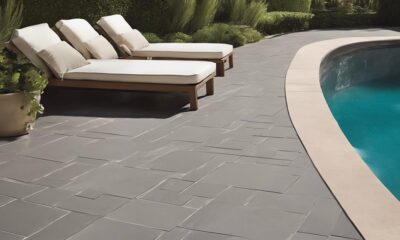
 Vetted6 days ago
Vetted6 days ago15 Best Tile Adhesives for Outdoor Use – Top Picks for Durable and Weather-Resistant Installations
-

 Beginners Guides2 days ago
Beginners Guides2 days agoDesigning Your Retreat Center – Essential Tips
-

 Beginners Guides4 days ago
Beginners Guides4 days agoAre Retreats Profitable
-

 Vetted5 days ago
Vetted5 days ago15 Creative Ways to Cover Up Popcorn Ceilings and Transform Your Space
-
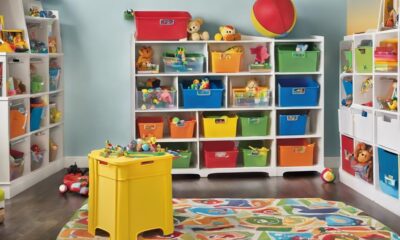
 Vetted4 days ago
Vetted4 days ago15 Best Playroom Storage Solutions to Keep Your Kids' Space Organized and Fun
-

 Vetted2 weeks ago
Vetted2 weeks ago15 Best Ways to Label Clothes for Nursing Home Residents – Stay Organized and Efficient
-

 Vetted7 days ago
Vetted7 days ago15 Best Plants to Thrive on the North Side of Your House – A Gardener's Guide
-

 Vetted2 weeks ago
Vetted2 weeks ago15 Best Boxwood Varieties for Thriving in Full Sunlight






